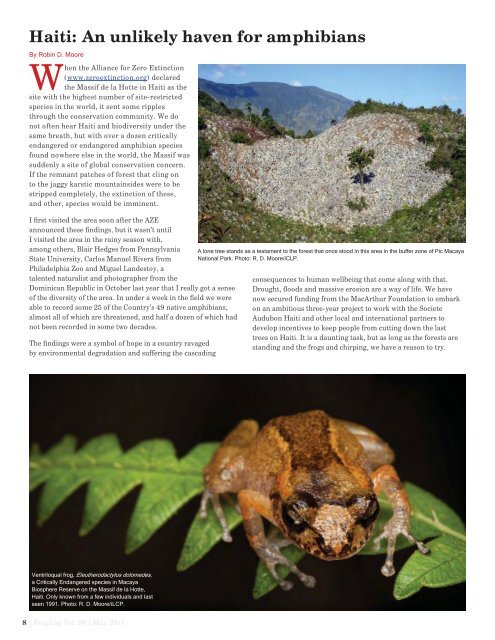download the FrogLog 96 - Amphibian Specialist Group
download the FrogLog 96 - Amphibian Specialist Group
download the FrogLog 96 - Amphibian Specialist Group
You also want an ePaper? Increase the reach of your titles
YUMPU automatically turns print PDFs into web optimized ePapers that Google loves.
Haiti: An unlikely haven for amphibians<br />
By Robin D. Moore<br />
When <strong>the</strong> Alliance for Zero Extinction<br />
(www.zeroextinction.org) declared<br />
<strong>the</strong> Massif de la Hotte in Haiti as <strong>the</strong><br />
site with <strong>the</strong> highest number of site-restricted<br />
species in <strong>the</strong> world, it sent some ripples<br />
through <strong>the</strong> conservation community. We do<br />
not often hear Haiti and biodiversity under <strong>the</strong><br />
same breath, but with over a dozen critically<br />
endangered or endangered amphibian species<br />
found nowhere else in <strong>the</strong> world, <strong>the</strong> Massif was<br />
suddenly a site of global conservation concern.<br />
If <strong>the</strong> remnant patches of forest that cling on<br />
to <strong>the</strong> jaggy karstic mountainsides were to be<br />
stripped completely, <strong>the</strong> extinction of <strong>the</strong>se,<br />
and o<strong>the</strong>r, species would be imminent.<br />
I first visited <strong>the</strong> area soon after <strong>the</strong> AZE<br />
announced <strong>the</strong>se findings, but it wasn’t until<br />
I visited <strong>the</strong> area in <strong>the</strong> rainy season with,<br />
among o<strong>the</strong>rs, Blair Hedges from Pennsylvania<br />
State University, Carlos Manuel Rivera from<br />
Philadelphia Zoo and Miguel Landestoy, a<br />
talented naturalist and photographer from <strong>the</strong><br />
Dominican Republic in October last year that I really got a sense<br />
of <strong>the</strong> diversity of <strong>the</strong> area. In under a week in <strong>the</strong> field we were<br />
able to record some 25 of <strong>the</strong> Country’s 49 native amphibians,<br />
almost all of which are threatened, and half a dozen of which had<br />
not been recorded in some two decades.<br />
The findings were a symbol of hope in a country ravaged<br />
by environmental degradation and suffering <strong>the</strong> cascading<br />
A lone tree stands as a testament to <strong>the</strong> forest that once stood in this area in <strong>the</strong> buffer zone of Pic Macaya<br />
National Park. Photo: R. D. Moore/iCLP.<br />
consequences to human wellbeing that come along with that.<br />
Drought, floods and massive erosion are a way of life. We have<br />
now secured funding from <strong>the</strong> MacArthur Foundation to embark<br />
on an ambitious three-year project to work with <strong>the</strong> Societe<br />
Audubon Haiti and o<strong>the</strong>r local and international partners to<br />
develop incentives to keep people from cutting down <strong>the</strong> last<br />
trees on Haiti. It is a daunting task, but as long as <strong>the</strong> forests are<br />
standing and <strong>the</strong> frogs and chirping, we have a reason to try.<br />
Ventriloqual frog, Eleu<strong>the</strong>rodactylus dolomedes,<br />
a Critically Endangered species in Macaya<br />
Biosphere Reserve on <strong>the</strong> Massif de la Hotte,<br />
Haiti. Only known from a few individuals and last<br />
seen 1991. Photo: R. D. Moore/iLCP.<br />
8 | <strong>FrogLog</strong> Vol. <strong>96</strong> | May 2011
















